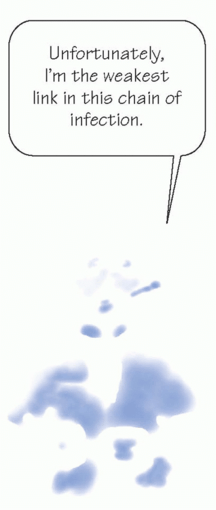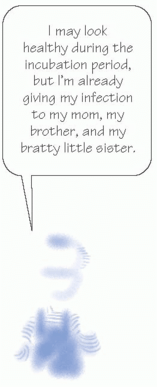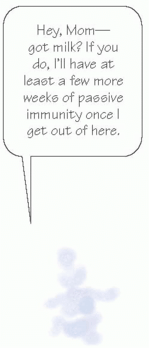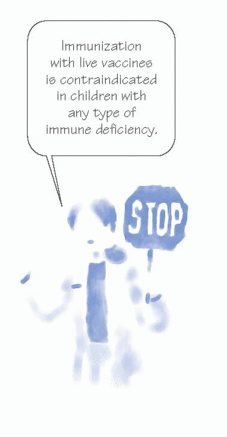Infectious diseases and immunizations
 Just the facts
Just the factsIn this chapter, you’ll learn:
the chain of infection
recommended immunization practices for infants and children
common childhood infectious diseases of viral and bacterial etiology
nursing interventions for the care of children with viral and bacterial illnesses.
Infection
Infection is the invasion and multiplication of microorganisms in the body. Infection can cause numerous illnesses during childhood, most of which are common, but some of which are less common or even rare.
The severity of illness caused by infection can range from subclinical to life-threatening. A thorough understanding of the etiology and symptoms of infectious diseases as well as the appropriate diagnostic and therapeutic interventions will help the nurse provide optimal care.
|
Chain of infection
Chain of infection is a term used to describe the circle of links needed for the transmission of infectious diseases
in humans. All links must be present and in order for an infection to occur.
in humans. All links must be present and in order for an infection to occur.
 The chain begins with a pathogen that’s capable of producing disease in humans, that is, bacteria, virus, fungi, or parasite.
The chain begins with a pathogen that’s capable of producing disease in humans, that is, bacteria, virus, fungi, or parasite. The reservoir of an infectious agent. This is where the infectious agent will grow. Humans are the most common reservoir. Other reservoirs include the environment, hospital settings, water supply, and rodents or animals.
The reservoir of an infectious agent. This is where the infectious agent will grow. Humans are the most common reservoir. Other reservoirs include the environment, hospital settings, water supply, and rodents or animals. The third link in the chain is the portal of exit. The pathogen leaves the reservoir via mucus, blood, or feces.
The third link in the chain is the portal of exit. The pathogen leaves the reservoir via mucus, blood, or feces. The fifth link in the chain is the portal of entry (the site where disease transmission occurs), through which a pathogen can enter the body by penetrating the skin or a mucous membrane barrier by direct contact or ingestion.
The fifth link in the chain is the portal of entry (the site where disease transmission occurs), through which a pathogen can enter the body by penetrating the skin or a mucous membrane barrier by direct contact or ingestion. The last link is the host; a susceptible host is necessary for an infectious disease to be transmitted.
The last link is the host; a susceptible host is necessary for an infectious disease to be transmitted.Immature immunity
Infants and children are susceptible to infectious diseases because their immune systems are immature. As children mature and grow, their exposure to infectious agents increases and they develop antibodies naturally. Subsequent infections with the same pathogen may be less severe or avoided completely.
Stages of infection
Infections follow a predictable sequence of events during transmission that results in five distinct stages of disease.
 The incubation period is the phase during which the pathogenic organism begins active reproduction in the host; the child has no clinical symptoms but may be contagious to others during this time.
The incubation period is the phase during which the pathogenic organism begins active reproduction in the host; the child has no clinical symptoms but may be contagious to others during this time. The prodromal phase is the initial appearance of clinical symptoms in the host; common symptoms include fever, malaise, headache, sore throat, cough, and rhinitis.
The prodromal phase is the initial appearance of clinical symptoms in the host; common symptoms include fever, malaise, headache, sore throat, cough, and rhinitis. During the acute stage, maximum symptoms are experienced by the host; toxins deposited by the pathogenic organism can produce tissue damage. (Inflammatory changes and tissue damage can also occur as a result of the immune response of the host.)
During the acute stage, maximum symptoms are experienced by the host; toxins deposited by the pathogenic organism can produce tissue damage. (Inflammatory changes and tissue damage can also occur as a result of the immune response of the host.)
|
 The convalescent stage is characterized by progressive elimination of the infection (or elimination of the pathogen), healing of damaged tissue, and symptom resolution.
The convalescent stage is characterized by progressive elimination of the infection (or elimination of the pathogen), healing of damaged tissue, and symptom resolution. The resolution stage is the host’s recovery from the infection without residual signs or symptoms of disease.
The resolution stage is the host’s recovery from the infection without residual signs or symptoms of disease.Cover your mouth, please
The period of communicability is the time when the infectious organism may move from the infected host to another person. It varies with different disease states but usually begins during the incubation phase.
Immune protection
Children receive protection from infectious diseases naturally and artificially.
Methods of obtaining immune protection
There are five different methods in which immune protection can be obtained: natural immunity, naturally acquired active immunity, naturally acquired passive immunity, artificially acquired active immunity, and artificially acquired passive immunity.
Natural (innate) immunity
Innate immunity is a combination of natural and nonspecific immunity that can protect the human body from pathogens and foreign agents. For example, the phagocytic action of white blood cells (macrophages) may be triggered by the body’s innate ability to recognize and distinguish normal cells from foreign cells. The body’s ability to distinguish self from non-self is natural, or innate, immunity.
Naturally acquired active immunity
Naturally acquired active immunity is obtained when the body’s immune system responds to a specific pathogen. Antibodies and memory cells prevent or reduce the severity of subsequent infection with that specific pathogen. Naturally acquired active immunity persists for many years.
Naturally acquired passive immunity
Naturally acquired passive immunity involves mother-to-fetus transmission of maternal antibodies.
A gift that keeps on giving …
The mother’s immunoglobulin G crosses the placenta and is transmitted to the fetus. After birth, the infant can receive passive immunity through maternal antibodies in breast milk.
|
… for up to 2 months
Naturally acquired passive immunity differs from active immunity. Although active immunity lasts many years, or even a lifetime, passive immunity lasts only as long as the antibodies remain in the blood of the fetus or infant (usually from a few weeks to about 2 months). Even so, some antibodies transferred across the placenta have been isolated up to age 1 year, which is why measles immunization must be delayed until age 15 months.
Artificially acquired active immunity
Artificially acquired active immunity is achieved by deliberate administration of a vaccine or toxoid. The vaccine or toxoid stimulates the immune system’s production of antibodies against a specific antigen, but symptoms of the disease aren’t produced in the person receiving the vaccine.
Artificially acquired passive immunity
Artificially acquired passive immunity is conferred when antibodies developed in another person or animal donor are injected into an individual. In pediatric patients, this transfer usually involves intravenous (I.V.) administration of a specific immunoglobulin, or antisera. Examples include:
gamma globulin (a mixture of antibodies against prevalent community diseases, pooled from 1,000 human plasma donors)
hyperimmune or convalescent serum globulin (such as tetanus antitoxin, hepatitis B immune globulin, and varicella-zoster immune globulin).
Types of immunizations
Various immunizations are given at specific times to protect pediatric patients from certain diseases. These vaccines fall into two general categories:
live, attenuated vaccines
inactivated vaccines.
Live, attenuated
Live, attenuated vaccines are created from a live organism that’s grown under suboptimal conditions to produce a live vaccine with reduced virulence.
Weak but stimulating
Thus, an attenuated immunization contains weakened microorganisms and stimulates immune response and production of antibodies in the host. The vaccine confers 90% to 95% protection for more than 20 years with a single dose.
Measles, mumps, and rubella—itch, ouch
Examples of live, attenuated vaccines include the measles, mumps, and rubella (MMR) vaccine; the rotavirus vaccine; and the varicella vaccine.
Inactivated
An inactivated, or killed, vaccine confers a weaker response than a live vaccine, necessitating frequent boosters.
An inactivated vaccine doesn’t promote replication and provides 40% to 70% protection.
Toxoids
Some bacteria, such as diphtheria, produce toxins, which cause disease. The vaccine to prevent a disease caused by a toxin is called a toxoid. A toxoid:
is another form of an inactivated vaccine
is a toxin that has been specially treated with formalin or heat to weaken its toxic effect but retain its antigenicity
provides 90% to 100% protection by stimulating the production of antibodies.
Inactive but popular
Examples of inactivated vaccines include:
diphtheria and tetanus toxoids
inactivated poliovirus vaccine (IPV)
pertussis vaccine
hepatitis B vaccine.
Immunization schedule
Childhood immunizations include the hepatitis A and B vaccines, diphtheria and tetanus toxoids and acellular pertussis (DTaP) vaccine, Haemophilus influenzae type B (Hib) vaccine, human papillomavirus (HPV) vaccine, influenza vaccine, IPV vaccine, meningococcal vaccine, MMR vaccine, rotavirus vaccine, varicella virus vaccine, and pneumococcal 13-valent conjugate vaccine (PCV). These immunizations are usually given according to a predetermined schedule. (See Recommended immunization schedule for children, page 170.)
Recommended immunization schedule for children
In addition to following the recommended immunization schedule for children in the following table, considering these simple steps will help ensure the child’s safety.
Before immunization
Obtain a history of allergic responses, especially life-threatening anaphylactic reactions to antibiotics or past vaccinations (certain vaccinations may be contraindicated in these children).
Assess the child for moderate or severe illness. Vaccinations may be delayed in these children until they recover. However, a child with a minor illness, such as a cold, may receive immunizations.
Keep in mind that children receiving corticosteroids for longer than 2 weeks, chemotherapy, or radiation therapy; those with human immunodeficiency virus infection, acquired immunodeficiency syndrome, or another disease that affects the immune system; and those with cancer will need special consideration for vaccination. (They may not be able to receive live virus vaccines, such as MMR, rotavirus, or varicella vaccines.)
After immunization
Tell the parents to watch for and report reactions other than local swelling and pain and mild temperature elevation.
Give parents the child’s immunization record.
2013 general vaccine recommendations
At right are the 2013 general vaccine recommendations approved by the Advisory Committee on Immunization Practices, the American Academy of Pediatrics, and the American Academy of Family Physicians.
|
Key:
DTaP: Diphtheria and tetanus toxoids and acellular pertussis
Hib: Haemophilus influenzae type B
HPV: Human papillomavirus
IPV: Inactivated poliovirus vaccine
MCV: Meningococcal conjugate vaccine
MMR: Measles, mumps, rubella
PCV: Pneumococcal conjugate vaccine
Td: Tetanus and diphtheria toxoids
Tdap: Tetanus and diphtheria toxoids and acellular pertussis
In the United States, immunization recommendations are governed by the Advisory Committee on Immunization Practices, the American Academy of Pediatrics, and the American Academy of Family Physicians.
Hepatitis A vaccine
Hepatitis A is recommended for all children starting at 12 months of age. It is also recommended for people at risk for acquiring hepatitis A. These people include:
people who live in endemic areas
military personnel or others traveling to high-risk areas of the world
persons at high risk (Native Americans, Alaskan natives, those with chronic liver disease, homosexual or bisexual adolescent males, or users of injectable and illicit drugs).
Dosing
This vaccine is a series of two doses given starting at age 12 months; the two doses should be administered at least 6 months apart. Children 12 months to 18 years of age receive two doses of 0.5 ml (given at least 6 months apart). Those 19 years and older receive 1 ml given intramuscularly (I.M.) (at least 6 months apart). (See Tips for pediatric injections, page 172.)
Adverse reactions
Adverse reactions to the hepatitis A vaccine are rare. Administration is contraindicated for those with febrile illness or bleeding disorders.
Hepatitis B vaccine
Acquired during childhood or adolescence, hepatitis B can cause acute illness, with anorexia, jaundice, diarrhea, vomiting, and fatigue. It can also have fatal long-term consequences from cirrhosis or liver cancer. The virus that causes hepatitis B can be spread by:
passing of the virus from an infected mother to her infant during birth
having unprotected sexual intercourse with an infected person
I.V. drug abuse or accidental needle-stick injuries
exposure to infected blood or body fluids.
Hepatitis B vaccine is indicated for infants, children, and adolescents to prevent hepatitis B.
Dosing
Various vaccine formulations are available in different strengths. Read the label carefully to determine the proper dosage for pediatric use.
Tips for pediatric injections
When giving a child an injection, the major goals should be minimizing trauma and discomfort while providing safe, efficient administration of a necessary medicine or vaccination.
Minimizing trauma
To most toddlers and preschoolers, and to many older children, the prospect of getting an injection is the most frightening part of a doctor’s visit or even a hospitalization.
Many strategies, including those outlined in the following texts, can be used to reduce the trauma of receiving an injection, while establishing trust between the child and the health care team and making future injections easier for the child (and for the nurse who’s giving the injection).
Medicine to keep you healthy
Give the child a simple, age-appropriate explanation for why the injection is being given. When a child is being vaccinated, that explanation might be, “This shot will give you medicine to keep you from getting sick.” (Young children may think an injection is being given as a punishment and may not even realize that medication is being given.)
Allow the child to give a “shot” to a doll or stuffed animal; this gives him a sense of control, lets him see that the injection has a beginning and an end, and gives him a concrete understanding of what will happen.
The best policy
Be honest; tell the child that it will hurt for a moment but that it will be over quickly. (Honesty promotes trust; if a nurse is honest about the potential for pain, the child will believe her when she tells him something won’t hurt.)
Coping and comfort
Give the child a coping strategy, such as squeezing his mother’s hand, counting to five, singing a song, and looking away.
Have a parent hold and comfort the child while the injection is being given. A parent’s presence reassures the child that nothing truly bad will happen. (The child may actually cry more when a parent is present, but this is because he feels safe enough to do so.)
Praise and cover
When the injection has been given, tell the child that “the hurting part” is over, and praise him for what a good job he did (regardless of how he reacted). Never tell a child to “be brave,” to “be a big boy,” or not to cry, as these requests will set the child up for failure.
Give the child a bandage. (A young child may not believe the “hurting part” is over until a bandage has been applied.)
Always give injections in a designated treatment area. Avoid performing painful procedures in a playroom or, if possible, in the child’s hospital room, because he needs to know there are places where he can feel completely safe.
Giving the injection
Apply firm pressure at the site for 10 to 15 seconds immediately before giving the injection to decrease discomfort (a numbing patch may be used).
When two or more injections are needed, give them simultaneously in different extremities; have two or more nurses to assist (and provide manual restraint, if needed) during the procedures. (The child has only one painful experience when multiple injections are given simultaneously; this is believed to be less traumatic than receiving painful injections one after the other.)
Apply bandages to each site, and immediately comfort and console the child following the injections.
Always keep resuscitation equipment and epinephrine readily available in case of an anaphylactic response to an immunization.
Baby’s first ouch
The vaccine is given I.M. at birth (or before hospital discharge) and again at ages 1 to 4 months and ages 6 to 18 months, for a total of three doses. For older children and adolescents, the initial I.M. dose should be given as early as possible, with the second dose given 1 month later and the third dose given 6 months after the first dose.
Positive mom, extra ouch
Before immunizing a neonate, check the results of the mother’s hepatitis B surface antigen (HBsAg) test. If the mother is HBsAgpositive or her HBsAg status is unknown, the vaccine must be given within 12 hours of birth, along with hepatitis B immune globulin (also within 12 hours of birth) administered in two different sites.
Adverse reactions
Common reactions are pain and redness at the site of injection and elevated liver enzymes. Mild to moderate fever may occur (more common in children and adolescents than in adults). Anaphylaxis is rare.
DTaP vaccine
The DTaP vaccine is given to protect infants and young children from acquiring diphtheria, tetanus, and pertussis. The bacterium that causes diphtheria can create a toxin that damages tissue and attacks the heart and nerves. Such an attack can be fatal. Tetanus can cause muscle spasms that can interfere with breathing, which can lead to death. Pertussis is particularly dangerous for young children, especially infants younger than age 1 year, who are most at risk for complications and death.
Dosing
The dosage for the DTaP vaccine is 0.5 ml given I.M. at ages 2 months, 4 months, 6 months, 15 to 18 months, and 4 to 6 years, for a total of five doses. The tetanus and diphtheria toxoids and acellular pertussis (Tdap) vaccine is given as a booster between ages 11 and 12 years and a tetanus and diphtheria toxoids (Td) booster is then given at 10-year intervals.
Adverse reactions
Fever, fussiness, and anorexia are common adverse reactions as well as redness, pain, and swelling at the injection site. Redness, pain, and swelling at the injection site occur more commonly after the fourth or fifth dose in the DTaP series. Anaphylaxis, fever above 102° F (38.9° C), persistent crying for 3 hours or longer, and seizures are rare but severe reactions that require emergency treatment.
|
Hib vaccine
The Hib vaccine is used to prevent infection with H. influenzae type B. This infection can lead to severe invasive illnesses, including meningitis, epiglottitis, and pneumonia. Until recently, H. influenzae type B was the most common cause of meningitis in children older than age 1 month, but vaccination with the Hib vaccine has drastically reduced the incidence.
Dosing
The Hib vaccine dosage is 0.5 ml given I.M. for three or four doses. Schedules for different product preparations vary. (Refer to the manufacturer’s guidelines and package inserts.)
Three for PedvaxHIB …
For the PedvaxHIB preparation, three total doses are recommended, with the first given at age 2 months, the second at age 4 months, and the third at ages 12 to 15 months.
… Omni, Act get one dose more
For other preparations, such as OmniHIB and ActHIB, four total doses are recommended, with the first given at age 2 months, the second at age 4 months, the third at age 6 months, and the fourth at ages 12 to 15 months.
Adverse reactions
Hib is one of the safest vaccines available because it causes only mild reactions, if any. Common adverse reactions are low-grade fever, localized pain, redness, and swelling at the injection site. Anaphylaxis is rare.
Human papillomavirus vaccine
The HPV vaccine is available for boys and girls age 9 and older to protect against HPV, which is associated with increased risk for developing certain cancers.
Dosing
HPV vaccine is 0.5 ml administered in three doses I.M. The vaccine series is usually offered around 11 to 12 years of age on a 0, 2-month, and 6-month schedule.
Adverse reactions
Side effects associated with the HPV vaccine include fainting and injuries associated with falling, dizziness, pain at site, fever, and nausea. The Centers for Disease Control and Prevention (CDC) and U.S. Food and Drug Administration (FDA) recommend that patients sit or lie down for 15 minutes after the injection.
IPV
The IPV is recommended to prevent infection with the poliovirus. The live oral trivalent polio vaccine (OPV) is no longer used in the United States.
Dosing
The IPV dose is 0.5 ml administered subcutaneously (S.C.) at ages 2 months, 4 months, 6 to 18 months, and 4 to 6 years, for a total of four doses.
Adverse reactions
Localized pain, redness, and swelling at the injection site are common adverse reactions, although IPV is safe and usually well tolerated. Anaphylaxis is rare.
MMR vaccine
The MMR vaccine stimulates immunity against measles, mumps, and rubella. Because the vaccine contains live virus, it’s contraindicated during pregnancy. Females shouldn’t become pregnant within 1 month of immunization.
Intact immunity required
Live virus shouldn’t be administered to anyone receiving immunosuppressive therapy or to those with immunodeficiency diseases.
Dosing
The MMR vaccine dose is 0.5 ml administered S.C. at ages 12 to 15 months and again at ages 4 to 6 years, for a total of two doses.
Adverse reactions
Common adverse reactions to the MMR vaccine are lowgrade fever for 1 week after immunization; localized pain, redness, and swelling at the injection site; rash; and joint pain. Severe reactions are rare but include viral encephalopathy and anaphylaxis.
Meningococcal vaccine
The meningococcal vaccine prevents most types of meningococcal infections and is recommended for all adolescents age 11 to 18.
Dosing
The dose of meningococcal vaccine is given I.M. at ages 11 to 12 years and a booster should be given at 16 years of age. Patients receiving their first dose between the ages of 13 and 15 need a booster between 16 and 18 years of age. Adolescents receiving their first dose after age 16 do not require a booster dose.
|
Adverse reactions
Side effects associated with meningococcal vaccine include redness and pain at the site; fever and dizziness have been reported. It has been recommended that patients sit or lie down 15 minutes after the vaccine.
Pneumococcal 13-valent conjugate vaccine
Pneumococcal 13-valent conjugate vaccine (PCV13) is recommended for preventing and decreasing the severity of pneumococcal infections caused by Streptococcus pneumoniae. These invasive infections can result in otitis media, pneumonia, meningitis, and sepsis, with the most serious illness occurring in children younger than age 2 years.
Dosing
The 0.5-ml dose of PCV13 is administered I.M. A total of four doses are recommended, with one dose each at ages 2 months, 4 months, 6 months, and 12 to 15 months.
Adverse reactions
Common adverse reactions from PCV are drowsiness, irritability, restless sleep, diarrhea, vomiting, decreased appetite, and injection site reactions (including swelling, redness, induration, inflammation, skin discoloration, and tenderness).
Rotavirus vaccine
The rotavirus is the leading cause of gastroenteritis in children younger than the age of 5 causing severe vomiting and watery diarrhea. Currently, there are two vaccines licensed in the United States to protect against rotavirus.
Dosing
The two vaccines RotaTeq and Rotarix are administered by mouth. RotaTeq is given in three doses at age 2 months, 4 months, and 6 months. Rotarix is administered at 2 and 4 months of age. The maximum age for the first dose is 14 weeks and 6 days, with the maximum age for the last dose in 8 months 0 days.
Stay updated, free articles. Join our Telegram channel

Full access? Get Clinical Tree


Get Clinical Tree app for offline access






